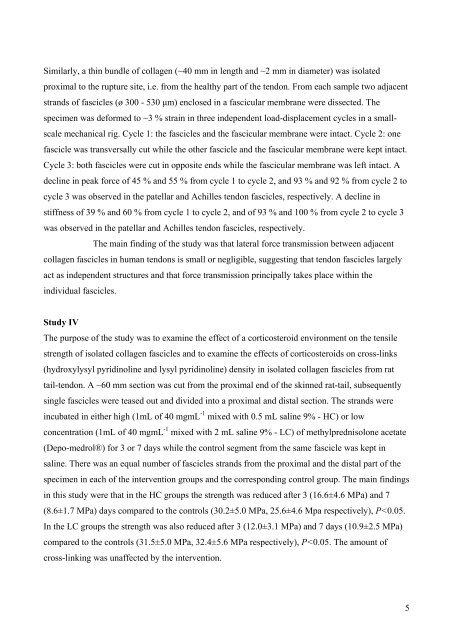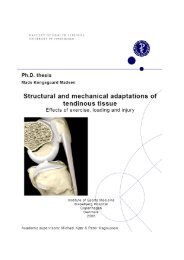Mechanical and structural properties of collagen fascicles ... - ISMC
Mechanical and structural properties of collagen fascicles ... - ISMC
Mechanical and structural properties of collagen fascicles ... - ISMC
You also want an ePaper? Increase the reach of your titles
YUMPU automatically turns print PDFs into web optimized ePapers that Google loves.
Similarly, a thin bundle <strong>of</strong> <strong>collagen</strong> (~40 mm in length <strong>and</strong> ~2 mm in diameter) was isolated<br />
proximal to the rupture site, i.e. from the healthy part <strong>of</strong> the tendon. From each sample two adjacent<br />
str<strong>and</strong>s <strong>of</strong> <strong>fascicles</strong> (ø 300 - 530 µm) enclosed in a fascicular membrane were dissected. The<br />
specimen was deformed to ~3 % strain in three independent load-displacement cycles in a small-<br />
scale mechanical rig. Cycle 1: the <strong>fascicles</strong> <strong>and</strong> the fascicular membrane were intact. Cycle 2: one<br />
fascicle was transversally cut while the other fascicle <strong>and</strong> the fascicular membrane were kept intact.<br />
Cycle 3: both <strong>fascicles</strong> were cut in opposite ends while the fascicular membrane was left intact. A<br />
decline in peak force <strong>of</strong> 45 % <strong>and</strong> 55 % from cycle 1 to cycle 2, <strong>and</strong> 93 % <strong>and</strong> 92 % from cycle 2 to<br />
cycle 3 was observed in the patellar <strong>and</strong> Achilles tendon <strong>fascicles</strong>, respectively. A decline in<br />
stiffness <strong>of</strong> 39 % <strong>and</strong> 60 % from cycle 1 to cycle 2, <strong>and</strong> <strong>of</strong> 93 % <strong>and</strong> 100 % from cycle 2 to cycle 3<br />
was observed in the patellar <strong>and</strong> Achilles tendon <strong>fascicles</strong>, respectively.<br />
The main finding <strong>of</strong> the study was that lateral force transmission between adjacent<br />
<strong>collagen</strong> <strong>fascicles</strong> in human tendons is small or negligible, suggesting that tendon <strong>fascicles</strong> largely<br />
act as independent structures <strong>and</strong> that force transmission principally takes place within the<br />
individual <strong>fascicles</strong>.<br />
Study IV<br />
The purpose <strong>of</strong> the study was to examine the effect <strong>of</strong> a corticosteroid environment on the tensile<br />
strength <strong>of</strong> isolated <strong>collagen</strong> <strong>fascicles</strong> <strong>and</strong> to examine the effects <strong>of</strong> corticosteroids on cross-links<br />
(hydroxylysyl pyridinoline <strong>and</strong> lysyl pyridinoline) density in isolated <strong>collagen</strong> <strong>fascicles</strong> from rat<br />
tail-tendon. A ~60 mm section was cut from the proximal end <strong>of</strong> the skinned rat-tail, subsequently<br />
single <strong>fascicles</strong> were teased out <strong>and</strong> divided into a proximal <strong>and</strong> distal section. The str<strong>and</strong>s were<br />
incubated in either high (1mL <strong>of</strong> 40 mgmL -1 mixed with 0.5 mL saline 9% - HC) or low<br />
concentration (1mL <strong>of</strong> 40 mgmL -1 mixed with 2 mL saline 9% - LC) <strong>of</strong> methylprednisolone acetate<br />
(Depo-medrol®) for 3 or 7 days while the control segment from the same fascicle was kept in<br />
saline. There was an equal number <strong>of</strong> <strong>fascicles</strong> str<strong>and</strong>s from the proximal <strong>and</strong> the distal part <strong>of</strong> the<br />
specimen in each <strong>of</strong> the intervention groups <strong>and</strong> the corresponding control group. The main findings<br />
in this study were that in the HC groups the strength was reduced after 3 (16.6±4.6 MPa) <strong>and</strong> 7<br />
(8.6±1.7 MPa) days compared to the controls (30.2±5.0 MPa, 25.6±4.6 Mpa respectively), P



